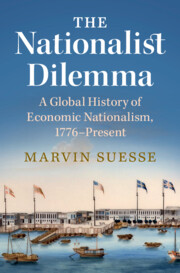Book contents
- The Nationalist Dilemma
- The Nationalist Dilemma
- Copyright page
- Dedication
- Contents
- 1 Introduction: Nationalists Think About the Economy
- 2 The American Community of the Common Man, 1776–1860
- 3 The Birth of the National Economy in Europe, 1789–1860
- 4 The Globalisation of the Nation, 1861–1913
- 5 The Nationalist as Saviour, 1914–1945
- 6 Policy in a World of Nation-States, 1946–1978
- 7 The Incomplete Building of a Global Economy, 1979–2001
- 8 Populist Discontents, 2002–2021
- 9 Conclusion and Outlook: Explaining Economic Nationalism
- Notes
- Index
4 - The Globalisation of the Nation, 1861–1913
Published online by Cambridge University Press: 25 April 2023
- The Nationalist Dilemma
- The Nationalist Dilemma
- Copyright page
- Dedication
- Contents
- 1 Introduction: Nationalists Think About the Economy
- 2 The American Community of the Common Man, 1776–1860
- 3 The Birth of the National Economy in Europe, 1789–1860
- 4 The Globalisation of the Nation, 1861–1913
- 5 The Nationalist as Saviour, 1914–1945
- 6 Policy in a World of Nation-States, 1946–1978
- 7 The Incomplete Building of a Global Economy, 1979–2001
- 8 Populist Discontents, 2002–2021
- 9 Conclusion and Outlook: Explaining Economic Nationalism
- Notes
- Index
Summary
Nationalist ideas on the economy went global in the late nineteenth century, affecting policy in Germany, the Austro-Hungarian Empire, Ireland, India, Russia, the Ottoman Empire and Japan. In general, policy makers considered closing the gap with Great Britain to be of paramount importance. This aided the spread of Listian ideas. However, these ideas were transformed by local conditions in the countries they impacted. Developmental approaches worked better if they could be tethered to indigenous ideas, as was the case in Japan. In Germany, Listian was transformed into an aggressive ideology of territorial expansion and national struggle. In colonial India and Ireland, opposition to British rule and the necessity of public mobilisation meant that industrialist ideas were supplemented with agrarian interests. In multi-ethnic locations, such as the Russian, Ottoman and Austro-Hungarian Empires, isolationist approaches came to the fore as nationalists looked to build ethnically homogenous economies separate from those of other nationalities.
Keywords
- Type
- Chapter
- Information
- The Nationalist DilemmaA Global History of Economic Nationalism, 1776–Present, pp. 76 - 120Publisher: Cambridge University PressPrint publication year: 2023



